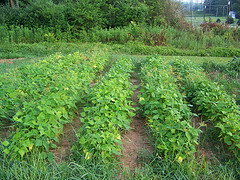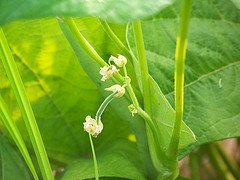Planting Green Beans is a Breeze!
Because the seeds are sowed directly in the garden, planting green beans is easy. Planting should be done at least 2 weeks after the last expected frost and after the soil temperature is above 60 degrees. Make sure the soil is well-tilled to a depth of at least 6 inches. You should also choose a location that will get full sun throughout the growing season.

Planting Bush Beans
To plant bush beans in a traditional garden, use a hoe and make rows approximately 1 1/2 inches deep and 2 feet apart. Sow the seeds every 2 inches and cover with soil. Water the rows in well.
In our own garden, we create raised rows before planting bush beans. We use a shovel and pile up soil so that it is about 6 inches high and 12 inches across for the length of the row. Then use use a hoe to create a small planting trench in the top of the raised row, which is where we sow our bean seeds. The raised rows accomplish a couple of different things. First, they help with drainage in our dense, clay-like soil. Second, they make harvesting the bush beans easier because we don't have to bend down as far to reach the beans.
If you are planting bush beans in a container, don't worry about creating rows. Instead, push seeds approximately 1 inch into the soil and space seeds 2 inches apart. Cover the seeds with soil and water them well. If you are planting green beans in a container garden, choose a container at least 8 inches deep. The bigger around the container is, the more beans you can grow. Also make sure there are plenty of drainage holes in the bottom of the container so that the roots don't sit in soggy soil.
When the plants are 3 inches tall, thin to one plant every 4-6 inches. Thinning plants means selectively removing seedlings. If the plants are growing too close together, problems may arise. The root systems will end up growing into each other. When plants have to battle each other for water and nutrients, they end up becoming stressed and rarely grow to full size or produce green beans. To solve this problem, seedlings are thinned to create adequate space between the plants. Thinning also allows you to selectively remove under-performing seedlings. To thin the plants, simply pull the seedlings to be removed out by the roots and toss them in your compost pile.
Yes, we know, thinning plants isn't fun. It's hard to destroy a potentially productive plant. However, it's better for the remaining plants in the long run.
Planting Pole Beans
To plant pole beans in a traditional garden, create mounds 8-12" tall, 2 feet across and 3 feet apart. Place your support structure in the center of the mound. You can use a stake, pole, cage or trellis for your support structure. If desired, pole beans can be planted in a single row along a fence. Be sure that your support structure is anchored well enough to the ground so that it won't blow over in high winds. Push seeds 1 inch deep and at least 4 inches apart into the soil around the support structure. Plant 3-4 seeds around each support structure. Cover the seeds with soil and water them in well. No thinning is necessary for pole beans.
In our own garden, we've grown pole beans on a variety of support structures. We've made teepee like structures out of 8 foot tall wood furring strips. We've also built temporary fences using chicken wire. We've also used metal stakes and strung twine between them at varying heights and allowed the pole beans to climb that way. We have a neighbor that uses cow pen panels to create an arch-shaped tunnel and then she plants the pole beans on either side and they climb up to the middle of the arch. Her method is pretty interesting because you're able to walk through this tunnel arch that is about 8 feet tall and 15 feet long with green beans hanging down from the top and sides. One great advantage to her method is that she's able to constantly be in the shade when she's harvesting her green beans.
If you are planting pole beans in a container, there is no need to create a mound. Other than that, follow the same planting instructions. Be sure to choose a container that is at least 12 inches deep and 18 inches across, with good drainage holes.
Now that you're done planting green beans, it's time to water and watch them grow.

Click here to learn about watering and fertilizing your green bean plants
Click here for information about harvesting green beans
Click here for green bean recipe ideas
Click here to leave our Planting Green Beans page and return to the Growing Green Beans main page
Click here to go to our Home page